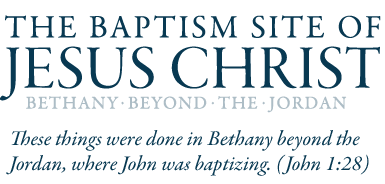Pre-Jesus
Pre-Jesus
HISTORY
God has granted to the land of Jordan many special places. The north of the country can boast of the homeland of the Prophet Elijah, and in the northern and central regions they take pride in the fact that Christ performed many miracles there and preached in their towns. The south is also very proud that John the Baptist was martyred in ‘Mekawer’ Castle, which is south of Madaba. In the Jordan River John baptized Jesus and there he met five of his disciples, including Peter. From here he set out preaching about the Kingdom of God, beginning the public part of his life.
Moses
Upon Mount Nebo, God revealed Himself to Moses, as He had previously revealed Himself at Sinai, and Moses stood and looked over the Promised Land stretched out in front of him. He saw the Jordan River before him, descending from the heights of Mount Hermon into the depths of the Jordan valley.
Joshua
After Moses passed away, Joshua, the son of Nun, crossed with the Israelites into the Promised Land.
Elijah and Elisha
But soon after their entrance into the Holy Land the people turned from the worship of God and took to worshipping strange gods. God sent to them many prophets to bring them back to true belief in His oneness and observance of His commandments. One of the most famous prophets was Elijah, who lived during the time of the rule of King Ahab in Israel. Ahab and his wife oppressed Elijah, and when Elijah grew old, God inspired him to leave and settle in what is today Jordan. So he left with his appointed successor, Elisha, who carried on his spirit and message. When they arrived at the River Jordan, Elijah struck it with his cloak and parted the waters of the river. He and Elisha crossed the dry land, and as they were speaking together upon the other side of the river, a fiery chariot came and carried Elijah into the heavens. (2nd Kings: 2)
John the Baptist
Again, hundreds of years passed and John the Baptist appeared at Bethany (Bayt ‘Anya) on the far side of the Jordan River (John 1:28 & John 10:40). He continued the path of faith and took the message from Moses “representative of the Holy Law” and from Elijah “representative of the prophets of the Old Testament” (Luke 1:17). John was the last prophet in the manner of the Old Testament prophets and the first prophet of the New Testament. He called the people to repent in preparation for the arrival of Christ, the Redeemer, and began to baptize in the Jordan River and the surrounding springs. The baptism he administered was a symbol of repentance and belief in God. Fleeing the authorities because of his sermons, he made for Bethany beyond the Jordan. He would sleep and rest in a cave close to the springs of “Saphsaphas” (what is today known as the Valley of Kharrar). The Bible states that here people from Jerusalem, Judea and the surrounding regions of the Jordan flocked to John for baptism. Jesus visited John here.
Then the Jews in Jerusalem sent some of the Scribes and Pharisees to question John, and John said to them, “I am not the Messiah, I am only a voice crying out in the wilderness saying, ‘Follow the path of God and make firm His path.’” (John 1:24)


